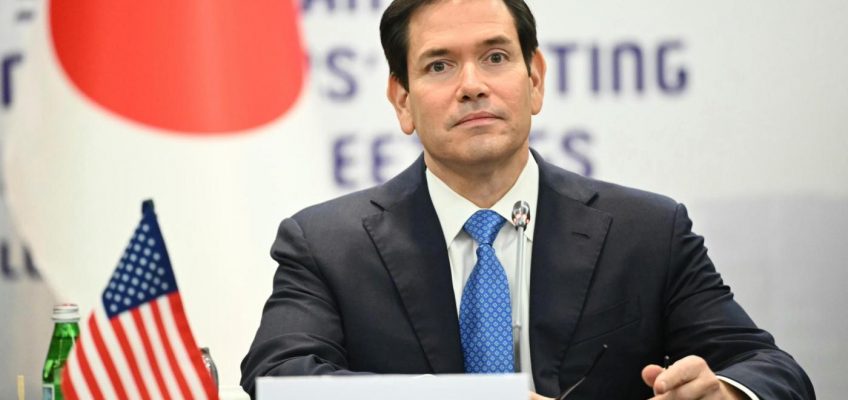By MATTHEW LEE, Associated Press Diplomatic Writer
KUALA LUMPUR, Malaysia (AP) — U.S. Secretary of State Marco Rubio said there were “areas of potential cooperation” between Washington and Beijing and stressed the importance of managing differences following his first in-person meeting with his Chinese counterpart as he wrapped up a two-day regional security forum in Malaysia.
Rubio and Chinese Foreign Minister Wang Yi met Friday on the sidelines of the Association of Southeast Asian Nations regional forum in Kuala Lumpur, Malaysia, as tensions between the two global powers continue to rise over trade, security, and China’s support for Russia’s war in Ukraine.
U.S. Secretary of State Marco Rubio, right, talks to Russia’s Foreign Minister Sergey Lavrov at the 15th East Asia Summit Foreign Ministers’ meeting during the 58th Association of Southeast Asian Nations (ASEAN) Foreign Ministers’ meeting and related meetings at the Convention Centre in Kuala Lumpur Friday, July 11, 2025. (Mandel Ngan/Pool Photo via AP)
“Look, we’re two big, powerful countries, and there are always going to be issues that we disagree on. I think there’s some areas of potential cooperation. I thought it was very constructive, positive meeting and a lot of work to do,” Rubio told reporters after the meeting.
Rubio also indicated that a potential visit to China by U.S. President Donald Trump to meet with President Xi Jinping was likely, saying: “The odds are high. I think both sides want to see it happen.”
Trade takes a back seat
While tariffs loomed in the background, Rubio said trade was not a major focus of his talks because “I’m not the trade negotiator.”
“We certainly appreciate the role trade plays in our bilateral relationships with individual countries. But the bulk of our talks here have been about all the other things that we cooperate on,” he said.
Related Articles
State Department is firing over 1,300 employees under Trump administration plan
Trump plans to tour Texas flood damage as the scope of the disaster tests his pledge to shutter FEMA
The newest way to influence Trump: Nominate him for the Nobel Peace Prize
Head Start will be cut off for immigrants without legal status, Trump administration says
Years later, Trump administration targets key figures in Russia investigation
U.S. State Department spokesperson Tammy Bruce said Rubio emphasized the importance of keeping channels of communication open during the China meeting.
The meeting was held less than 24 hours after Rubio met in Kuala Lumpur with another rival, Russian Foreign Minister Sergey Lavrov, during which they discussed potential new avenues to jumpstart Ukraine peace talks.
The high-level meetings took place amid regional unease over U.S. policies — especially Trump’s threats t o impose sweeping new tariffs on both allies and adversaries. Southeast Asian leaders voiced concerns, but according to Rubio, many prioritized discussions on security issues, their concerns about Chinese domination and desire for cooperation with the U.S.
“Of course, it’s raised. It’s an issue,” Rubio said. “But I wouldn’t say it solely defines our relationship with many of these countries. There are a lot of other issues that we work together on, and I think there was great enthusiasm that we were here and that we’re a part of this.”
Security issues looms large
However, Trump sees China as the biggest threat to the United States in multiple fields, not least technology and trade, and like previous U.S. presidents has watched the country greatly expand its influence globally while turning increasingly assertive in the Indo-Pacific, notably toward its small neighbors over the South China Sea and Taiwan.
Trump has warned of massive tariffs that he could impose on Chinese exports to the United States and preliminary discussions between the two sides have yet to produce significant progress.
Since former President Joe Biden was in office, the U.S. has also accused China of assisting Russia in rebuilding its military industrial sector to help it execute its war against Ukraine. Rubio said the Trump administration shares that view.
“I think the Chinese clearly have been supportive of the Russian effort, and I think that generally they’ve been willing to help them as much as they can without getting caught,” Rubio said Thursday.
China criticizes Trump’s tariffs
Rubio and Wang had been shadowboxing during the two-day ASEAN meeting, with each touting the benefits of their partnership to Southeast Asian nations.
Rubio has played up cooperation, including signing a civil-nuclear cooperation agreement with Malaysia, while Wang has railed against Trump’s threatened tariffs and projected China as a stable counterweight in talks with ASEAN counterparts on the sidelines.
“The U.S. is abusing tariffs, wrecking the free trade system and disrupting the stability of the global supply chain,” Wang told his Thai counterpart Maris Sangiampongsa, according the Chinese foreign ministry.
Chinese Foreign Minister Wang Yi attends the 26th ASEAN Plus Three Foreign Ministers’ Meeting at the Kuala Lumpur Convention Centre in Kuala Lumpur, Malaysia, July 10, 2025. (Hasnoor Hussain/Pool Photo via AP)
In a meeting with Cambodian Deputy Prime Minister Prak Sokhonn, Wang said that the tariffs are “an attempt to deprive all parties of their legitimate right to development.”
“In the face of turbulent global situation, China is willing to be Cambodia’s trustworthy and reliable friend and partner,” he added.
Wang also met with Lavrov on Thursday, where the two offered a joint message aimed at Washington. “Russia and China both support ASEAN’s central role in regional cooperation… and are wary of certain major powers creating divisions and instigating confrontation in the region,” Russia’s foreign ministry said in a statement.
But Rubio found support from Australian Foreign Minister Penny Wong, who said Friday that continued U.S. engagement was crucial for regional stability.
“We want to see a region where no one country dominates and no country is dominated,” Wong told reporters when asked about China’s rising might in the region. “We want to see a region where there is a balance of power… where there is no coercion or duress.”
At the same time, Wong said Australia is committed to maintaining a stable relationship with China, noting that engagement remains the best path forward.
Associated Press writers Huizhong Wu in Bangkok and Eileen Ng in Kuala Lumpur, Malaysia, contributed to this report.



